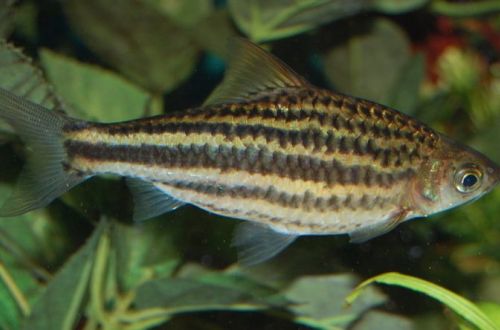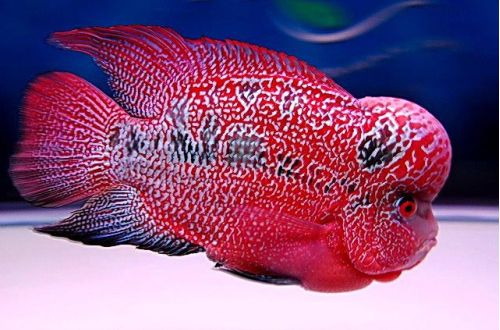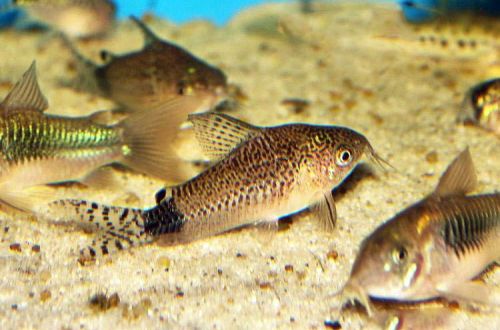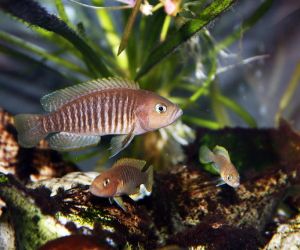
Barbus five-line
The five-lined barb or Striped barb, scientific name Desmopuntius johorensis, belongs to the Cyprinidae family. An interesting fish with an original body pattern. It is unpretentious in content and has a peaceful disposition, which makes it a great addition to any community aquarium.

Habitat
It comes from the reservoirs of Southeast Asia on the territory of modern Thailand, Indonesia on the island of Sumatra. They live in peat bogs of small channels of slow-flowing rivers in areas with dense benthic or coastal vegetation. Water often has a brown tint due to dissolved organic decay products (grass, leaves, algae, etc.). feed mainly on small aquatic insects and their larvae, zooplankton.
Brief information:
- The volume of the aquarium – from 150 liters.
- Temperature – 22-25°C
- Value pH — 5.0–7.0
- Water hardness – 1–10 dGH
- Substrate type – dark soft
- Lighting – subdued
- Brackish water – no
- Water movement – little or no
- The size of the fish is up to 12 cm.
- Food – any food
- Temperament – peaceful
- Keeping in a group of 8-10 individuals
Description
Narrow slender body (in females, the body is higher). Near the mouth there are four filamentous processes – antennae, two on each side, with the help of which the fish explores the ground in search of food. The coloration is pinkish-gold with rows of longitudinal dark stripes stretching across the entire body. Females are less intensely colored and look paler than males. Outwardly, it is almost identical to the Barb linear and the Three-ribbed barb.
Food
They accept all types of dry, frozen and live food. The optimal combination is as follows: dry flakes or granules mixed with pieces of frozen / live foods (daphnia, bloodworms, brine shrimp). If it is not possible to purchase live food, give preference to dry food, but the composition must contain protein supplements in the form of freeze-dried / dried pieces of the same bloodworm, for example. Purchase additional vegetable flakes, which should be fed along with the main food.
Maintenance and care
The preparation of water is of key importance; it should be soft and slightly acidic. Use special reagents and a water test kit (sold in pet stores and online) to achieve the desired values. It is recommended to update part of the water weekly by 10–20% of the tank volume. It should be noted that the water in a mature aquarium naturally becomes slightly acidic as a result of the oxidation of fish waste products (excrement, food residues), so maintaining the required parameters is not artificially required. The minimum required set of equipment consists of a filter, an aerator, a heater and a lighting system set to subdued light.
Design: soft ground of fine sand, possibly silty, with a large number of low and low rooted plants. Don’t let the aquarium become overgrown, the fish need space to swim. Floating plants are welcome, they provide additional shading. The presence of shelters is mandatory – the roots and branches of trees, various snags.
Social behavior
Peace-loving accommodating, but shy fish, prefers to stay in a flock. Compatible with most species originating from the waters of Southeast Asia, similar temperament. In no case do not allow joint keeping with aggressive fish, even if they are smaller in size than the Five-line Barb.
Breeding / breeding
Breeding is quite simple, there is a high probability that fry will appear in the general aquarium without your intervention. During spawning, the female scatters the eggs directly on the substrate, and the male fertilizes it. Due to weak parental instincts, Barbs often eat their own caviar, therefore, in order to prevent this, a fine mesh is laid out on the bottom through which the eggs pass, or small dense grass is planted on the bottom.
The fry appear within 2 days, and already on the third day they begin to swim freely, at this moment it is advisable to catch them and place them in a separate tank, since for other fish they seem to be an excellent addition to the diet. Feed micro food, finely ground dry flakes.
Fish diseases
The striped barb has good endurance, diseases appear only in weakened fish as a result of poor nutrition and / or unsuitable conditions. Infection is also possible through contact with already sick fish. Read more about symptoms and treatments in the Aquarium Fish Diseases section.





